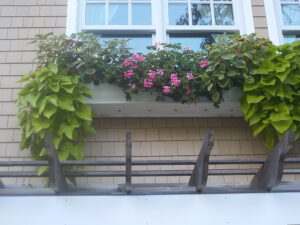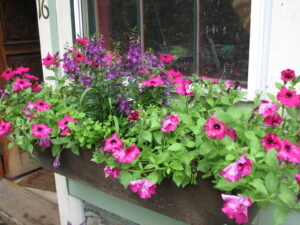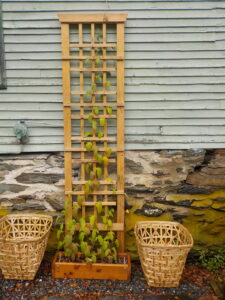Window Boxes: Something Everyone Can Have
Posted on Tuesday, August 8, 2023 · Leave a Comment
You may not have the time and energy to weed and maintain lovely perennial flower beds – or even to grow a few tomatoes, carrots and beans. But if you love flowers, you can have a window box or a big pot of flowers on your deck. They can add a punch of color all summer long. And it’s not too late to start now.
Before you get too excited about planting flowers at this time of year, visit your local garden center, farm stand or other source for plants. Some places sell out by the end of June, others keep nice annual flowers coming all summer long. And some are already selling chrysanthemums and fall asters which will provide nice color for the weeks ahead.

Caroline Storrs waters her window boxes every day
I recently visited Caroline Storrs of Cornish, NH to look at her window boxes as she told me hers were in their full glory now. Her husband, Peter, is a retired building contractor who built her window boxes for her. He used a synthetic wood made from PVC plastic for the window boxes. That material is more expensive than wood, but does not rot, warp or splinter. There are several brands available, and from what I can see synthetic wood costs from $10 to $15 per square foot of material.
Caroline explained that their window boxes were made wider and deeper than most commercially made window boxes. She said that the bigger the space available to the plant roots, the bigger the plants will grow – whether in pots or window boxes. She also pointed out that window boxes should be mounted so that there is an air space behind the boxes to prevent rotting the wood siding or clapboards.
The potting mix is also important. Caroline’s boxes run all the way across the garage beneath upstairs windows – for perhaps 30 feet. They are about 10 inches deep and 8 inches across, which means that a huge amount of potting mix is needed to fill them all. She makes her own potting mix instead of buying it in bags, which would be more expensive.
Caroline makes a planting mix of one third peat moss, one third perlite and one third compost (which she gets by the pickup truck load), mixing it in a big wheelbarrow. She also adds a slow-release fertilizer as the basic ingredients of the mix do not provide enough of the needed nutrients to sustain the plants all summer.

My window box with Supertunias and more
Not all annuals do well with high-nitrogen mixes, however, as they can grow tall but delay flowering. Plants grown for their foliage do well with lots of nitrogen, but may need pinching back to control size. If you do not use a slow-release fertilizer, you may need to use a liquid fertilizer every week or two to keep your plants happy.
Perlite is the white fluffy stuff in potting mixes that looks like bits of Styrofoam but is actually volcanic glass that is superheated until it pops like popcorn. It helps keep a planting mix from compacting. And although it does retain some water in its nooks and crannies, it does not absorb water.
Vermiculite is another material used in some potting mixes, and this does absorb water and holds it much better than perlite. It holds onto minerals, too, which perlite does not do. That’s important if you use liquid fertilizers which can wash away quickly.
I’ve read that too much vermiculite can lead to constantly a constantly wet mix, leading to root rot. From my experience, a mix of perlite and vermiculite is good, particularly in dry summers. Perhaps one part vermiculite and two parts perlite would be good. Vermiculite is mica that has been heated to a high temperature. Both products have a neutral pH.
In each window box Caroline planted geraniums, chartreuse-colored sweet potato vines and coleus, a foliage plant. Coleus now comes in both sun and shade varieties, and some that will grow in either sun or shade. It does not appear to bloom, but has multi-colored leaves that can be striking. The sweet potato vine hangs down and out of the box, while the coleus grows up and the geraniums add bold color in the middle of each box. She repeated the pattern all the way across the front of the garage to great effect.
Watering is important. Because her plants are so big and leafy, they require lots of water. Caroline told me that she waters every day – which means they do not travel in the summer. Peter told me that he drilled lots of holes in the bottom of the boxes to prevent the soil mix from staying soggy in rainy times. The holes can leak soil mix, so it is important to put landscape fabric or screen in the bottom.
I built a cedar window box more than 20 years ago and although it is starting to show its age, it is still sturdy. I did not treat it with anything. I recently made another similar box also using 6-inch wide cedar boards.

This small cedar window box is fine for a few morning glories
My new planting box is made for morning glories. I have a blank wall to which I attached a nice wood trellis and wanted to break up the tedium of the wall. And although 6-inch boards do not provide the depth of Caroline’s boxes, the vines have already reached the top of the six-foot trellis.
Gardening really is for everybody, even those with limited time, energy and space. Grow a few flowers in a window box or pot and they will reward you with their beauty – and that of the butterflies they attract.
Henry lives and gardens in Cornish Flat, NH. He is a lifelong organic gardener, and the author of 4 gardening books. You may reach him at henry.homeyer@comcast.net.





